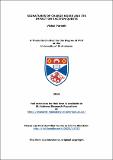Files in this item
Signatures of charge noise and its impact on exciton qubits
Item metadata
| dc.contributor.advisor | Lovett, Brendon W. | |
| dc.contributor.author | Purohit, Vishal | |
| dc.coverage.spatial | iv, 160 p. | en_US |
| dc.date.accessioned | 2017-09-28T15:41:38Z | |
| dc.date.available | 2017-09-28T15:41:38Z | |
| dc.date.issued | 2016-06 | |
| dc.identifier | uk.bl.ethos.725082 | |
| dc.identifier.uri | https://hdl.handle.net/10023/11753 | |
| dc.description.abstract | The research contained within this thesis concerns the detection, identification and effect of charge noise on quantum dot systems. In the first research chapter we study the cross correlation between pairs of exciton qubits subject to a common fluctuating charge environment, whose dynamics are solved using a transfer matrix approach. Our results show that we are able to discern features showing whether or not the charges interact with both quantum dots simultaneously i.e., form a correlated noise source. We find that qubits in a common charge environment display photon bunching, if both dots are driven on resonance or if the laser detunings are equal in both qubits and anitibunching if the laser detunings are in opposite directions. In the second research chapter we study the auto-correlation function of a single optically driven exciton qubit interacting with an environment consisting of 1/f noise and a fluctuating charge. We again use the transfer matrix method and a sum of Lorentzian distributions to approximate 1/f noise. Our simulations show that signatures of 1/f noise do exist in photon correlation measurements. From such measurements we are also able to determine a minimum cut-off frequency of the 1/f noise, in the case that there is such a cut-off. In addition we also show that a 1/f and a single fluctuator can be distinguished using the auto-correlation. In the final research chapter we study a pair of quantum dots, each with a low lying electron spin qubit and one higher lying level that can be selectively optically excited from one of the two spin states. Entanglement between the two spins can be achieved through path erasure. We look at the effect of a single fluctuating charge of the entanglement between these two `L' shaped electronic structures. | en_US |
| dc.language.iso | en | en_US |
| dc.publisher | University of St Andrews | |
| dc.subject.lcc | QC611.6Q35P8 | |
| dc.subject.lcsh | Quantum dots | en |
| dc.subject.lcsh | Coherence (Nuclear physics) | en |
| dc.subject.lcsh | Quantum theory | en |
| dc.title | Signatures of charge noise and its impact on exciton qubits | en_US |
| dc.type | Thesis | en_US |
| dc.type.qualificationlevel | Doctoral | en_US |
| dc.type.qualificationname | PhD Doctor of Philosophy | en_US |
| dc.publisher.institution | The University of St Andrews | en_US |
This item appears in the following Collection(s)
Items in the St Andrews Research Repository are protected by copyright, with all rights reserved, unless otherwise indicated.

